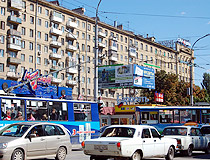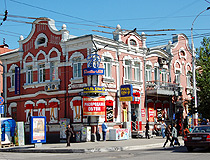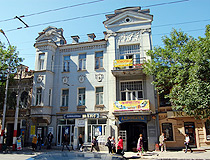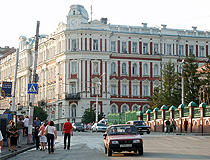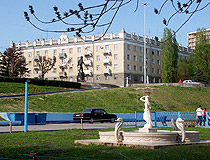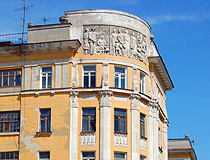History of Saratov
Foundation of Saratov
People already lived on the site of today’s Saratov in ancient times. On the territory of the city there is Alekseevskoye settlement — an archaeological monument that has seven identified cultural horizons from the catacomb culture of the Middle Bronze Age (the 20th-19th centuries BC) to the settlements of the Golden Horde time (the 13th-14th centuries AD) with a temporary break in the 5th-13th centuries.
The settlements in this place regularly appeared during periods of relatively stable state structures (Khazar Khaganate, Volga Bulgaria, Golden Horde) and disappeared without a trace during the next wave of nomads. The last such cycle before the founding of Saratov ended in 1395-1396, during the invasion of Tamerlane (Timur), who destroyed the Golden Horde town of Uvek (Ukek) that stood here.
In the next 200 years, the sparse population of this region was represented by Nogai and then Kalmyk nomads, Cossacks and fishing artels of Russian monasteries. After the military campaigns of Russian troops against the Kazan Khanate in 1552 and the Astrakhan Khanate in 1556, the Tsardom of Russia gained control of vast territories of the Volga Region. Under Tsar Fyodor Ivanovich, it was decided to found several new fortified towns on the Volga River.
In the summer of 1586, the Samara fortress was founded, in the summer of 1589 — Tsaritsyn (Volgograd). In the summer of 1590, halfway between Samara and Tsaritsyn, the Saratov fortress was founded. The exact location of the original Saratov is unknown. In the winter of 1613-1614, the fortress burned down. In 1617, it was rebuilt on the left bank of the Volga, at the mouth of the Saratovka River.
In 1674, Saratov was moved to the right bank of the Volga, to the area of the present Muzeynaya Square. Thus, the city of Saratov was founded three times: in 1590, 1617, and 1674, and each time in a new place.
More Historical Facts…
Saratov in the 18th-19th centuries
In 1700, the population of Saratov was about 2,000 people. The sedentary agricultural population for a long time could not populate the territory of the region. Only those who were attracted by the free life of the Cossacks moved here.
The construction of the Tsaritsyn guard line and other measures taken by Peter I to strengthen security created conditions for the settlement of the right bank of the Volga. Its location at the intersection of the shortest land route to Moscow and the water route from the lower Volga and the Caspian made Saratov an important transit point and a major center for trade in fish and salt.
In 1763, foreigners were invited to settle in the Volga Region. In 1766, Saratov became the center of coordination of German colonists. In 1780, the town became the center of the Saratov Vicegerency. In 1796, it was renamed the Saratov Governorate.
In 1811, the population of the town was 26,700 people. The general plan of Saratov, approved in 1812, became the basis for the development of the town for more than a hundred years. The French invasion of Russia (1812) influenced the life of Saratov. In 1813, the French prisoners of war were exiled here and used for public works to level ravines, build dams, plant gardens. Later, a lot of them took Russian citizenship and stayed in Saratov. Some of them were invited as tutors and teachers to Russian families and educational institutions, others opened their workshops.
In 1828, the Saratov Tobacco Factory, one of the first in the Russian Empire, began production. In addition to it, the town had a rope, tannery, bell, brick, and a number of other factories. Cholera epidemics broke out in Saratov in 1830 and 1848. The epidemic of 1830, which lasted more than one month, claimed up to 10,000 people.
The further growth of crafts and trade stimulated the development of river shipping on the Volga, which became the main transport artery of the Russian Empire. In the 19th century, Saratov turned into a major river port. A very strong impetus for the development of the Saratov Governorate was the construction of the Tambov — Saratov railway in 1871. It connected Saratov with the country’s railway network.
In 1876, the first stationary circus in the Russian Empire was built in Saratov. In 1885, a public art museum was opened, which became a major event in the cultural life of the city. In the end of the 19th century, Saratov was one of the largest centers for the grain trade and flour-grinding industry in the country. It became a major intermediary in the trade of oil products, meat, fish, salt, and wool.
Saratov in the 20th century
In 1908, trams began to carry passengers in Saratov — one of the oldest tram systems in Russia. In 1912, the Saratov Conservatory was opened — the third in the country after Moscow and St. Petersburg. In 1914, its population was 235,300 people. Until the end of the 1920s, Saratov remained the largest of the cities of the Volga Region (larger than Kazan, Nizhny Novgorod, Samara, etc.) and was often unofficially called the “capital of the Volga region”. From 1928 to 1932, Saratov was the administrative center of Lower Volga Krai, since 1934 — Saratov Krai, since 1936 — Saratov Oblast.
The rapid development of the city took place during the Second World War, when a number of factories and military schools were evacuated here from the west of the USSR. Saratov was subjected to several German air raids, the main purpose of which was to destroy the bridge over the Volga and the oil refinery.
Before the war, the town of Pokrovsk (Engels) located just across the Volga River was the capital of the German autonomous region with a population of about 800,000 people. A lot of them (about 400,000) were exiled to Siberia and Kazakhstan during the war; some later came back. Since the 1980s, most of them have emigrated to Germany. Until now, the few surviving buildings in the pseudo-Gothic style remind of this page in the history of Saratov.
Yuri Gagarin, the first man in space, studied in Saratov. In 1955, he graduated with honors from the Saratov Industrial College. After his historic flight, Gagarin also landed about 35 km from Saratov — on the left bank of the Volga.
Saratov’s population peaked in 1987 — 918,000 people. Until 1992, Saratov was a closed city (foreigners were not allowed to visit it), since several large enterprises of the Soviet defense industry worked in the city, in particular, the Saratov Aviation Plant, which produced military and civil aircraft. Several industrial enterprises in Saratov also carried out orders for the Soviet space program.
Streets of Saratov
Street traffic in Saratov
Author: Kiyanovsky Dmitry
Picturesque old building in Saratov
Author: Kiyanovsky Dmitry
Architectural monument in Saratov
Author: Kiyanovsky Dmitry
Saratov — Features
Saratov stretches for 34 km along the right bank of the Volgograd Reservoir (the Volga River) opposite the mouth of the Saratovka River and the city of Engels, which is located on the opposite bank. The distance from Saratov to Volgograd — 376 km, Samara — 425 km, Moscow — 847 km. The City Day of Saratov is celebrated on the second Sunday in September.
There are several hypotheses about the origin of the name of Saratov. One of the main versions is that Saratov got its name from Sokolovaya Mountain, which was called “sary tau” in Tatar meaning “yellow mountain”. There is an assumption that the name came from the words “sar atav” — “low-lying island” or “saryk atov” — “hawk island”. It is also possible that Saratov got its name from the Scythian-Iranian hydronym “Sarat”.
Three silver fish (sterlet) are depicted on the coat of arms of Saratov symbolizing “the great abundance of such fish in this area”. They form the Greek letter “upsilon” meaning “the choice of a worthy path at the crossroads of life’s roads”.
The climate in Saratov is moderately continental. This city is characterized by long (about four months), moderately cold winters and hot, often dry summers. The average temperature in January is minus 7.5 degrees Celsius, in July — plus 22.6 degrees Celsius. The best time to visit Saratov is from late May to early September.
Saratov is located at the intersection of main railway and highway lines, water routes. The international airport “Gagarin” offers regular flights to Yekaterinburg, Krasnodar, Moscow, Nizhny Novgorod, St. Petersburg, Sochi, Surgut, Ufa.
Trains to Moscow regularly depart from Saratov railway station, as well as passing trains to Adler, Astrakhan, Volgograd, Yekaterinburg, Kislovodsk, Kirov, Krasnoyarsk, Nizhnevartovsk, Nizhny Novgorod, Novokuznetsk, Novorossiysk, Perm, St. Petersburg, Simferopol, Tyumen, Chelyabinsk. The river port of Saratov serves only passengers of intercity cruise ships.
Saratov is a large industrial, cultural and educational center. Machine building, chemical and oil industries are well developed here. There are a lot of various attractions in Saratov: historical, architectural, religious and natural, various museums and beautiful parks. The city has a large number of architectural monuments of the late 19th — early 20th centuries.
Main Attractions of Saratov
Victory Park on Sokolovaya Mountain. This memorial complex was created in Saratov in 1975, when the 30th anniversary of the Victory in World War II was celebrated. This large park covers an area of 80 hectares. Here you can find the Eternal Flame, the Museum of Military and Labor Glory, the 40 meters high monument “Cranes”, and a unique exposition of military and civilian equipment with over 200 exhibits.
In 2003, the National Village of the Peoples of Saratov Oblast was opened in the park with real houses, yurts and other dwellings of the peoples of the region. In this place you can feel the atmosphere of the past not only of Russians, but also of Tatars, Armenians, Bashkirs, Georgians, and other peoples living in the Saratov region. In 2013, the Alley “Days of Russian Military Glory” was solemnly opened, on which monuments to prominent Russian commanders and statesmen were erected.
Victory Park is a favorite place for recreation for locals and visitors of the city. The top of Sokolovaya Mountain is one of the highest points in Saratov (165 meters). The observation deck located here offers a magnificent view of Saratov, the Volga River and its islands, the opposite bank, and the city of Engels (Saratov is connected with it by a bridge). Sokolovaya Street.
Cosmonauts Embankment — a street that stretches for 1.5 km along the Volga to the Saratov Bridge. The embankment received its present name in 1962 — after the first cosmonaut of our planet landed near Saratov. The monument to Yuri Gagarin was erected at the beginning of the embankment more than 30 years later. The embankment descends to the Volga in 4 wide terraces. In summer, there is a rental of bicycles, rollers, and gyro scooters.
In 2017, the floating light and music fountain “Heart of the Volga” was opened here. It is located right on the water, its multicolored jets rise to a height of 40 m. The fountain is open from May to October.
The embankment offers an excellent view of the Saratov Bridge (1965) — a reinforced concrete road bridge across the Volga River connecting Saratov with the city of Engels. The length of the bridge is over 2.8 km. It is one of the symbols of Saratov.
Kirov Avenue — a pedestrian street that stretches for 1 km through the historic center of Saratov. Unofficially, the street is called “Saratov Arbat”. Along the entire length of the street there are mansions and houses built in the late 19th — early 20th centuries. The most interesting ones are the neo-Gothic building of the Saratov Conservatory (1902) and the Volga Hotel (1917) built in the Art Nouveau style. The monument to the Saratov accordion, one of the symbols of Saratov, is installed here.
The walking area starts from Kirov Square, where one of the oldest stationary circuses in Russia is located — the Nikitin Brothers Circus. The fountain near the circus is a traditional meeting place. The building of the Covered Market (1916) located here is also worth mentioning.
Pictures of Saratov
The building of the Volga railway administration in Saratov
Author: Kiyanovsky Dmitry
Summer in Saratov
Author: Kiyanovsky Dmitry
Saratov architecture
Author: Kiyanovsky Dmitry
Church of the Icon of the Mother of God (1904-1906) — a very picturesque church, the main feature of which is that its multicolored domes resemble the Cathedral of St. Basil the Blessed standing on Red Square in Moscow. In Soviet times, the building served as a city planetarium. So it has been fairly well preserved. Volzhskaya Street, 36.
Cathedral of the Life-Giving Trinity (1689-1695) — the main Orthodox church in Saratov, a unique architectural monument for the Saratov region built in the Moscow baroque style. Moskovskaya Street, 6.
Saratov Regional Museum of Local Lore — the largest museum organization in Saratov Oblast. In total, the museum has about 400 thousand exhibits: archaeological, ethnographic, paleontological, entomological collections, examples of manuscript and early printed books, objects of religious worship, poster graphics, numismatics, materials on the history of the political, economic, and cultural life of Saratov.
Among the numerous exhibits on display in 30 spacious halls, it is worth highlighting the complete skeleton of an ichthyosaur, utensils belonging to the 4th century BC, a rare saber granted by Empress Elizabeth to the clerk Panteley Selivanov. In addition to the permanent exhibition, the museum organizes thematic exhibitions. Lermontova Street, 34.
The Radishchev Art Museum. Created in 1885, it became one of the first publicly accessible art museums in the Russian Empire. The ground floor displays medieval icons and a collection of Western European art, which is considered the third largest in Russia. These are canvases by Dutch, German, French, and Italian artists, furniture and porcelain, bronze and glass products.
On the second floor, you can see the works of Russian painters. Musical concerts and literary and art meetings are held in the Great Hall of this art museum. The library of the museum has a rich collection of manuscripts, old books. Radishchev Street, 39.
Museum of Samovars. This private museum, opened in 2015, houses the largest collection of samovars in Russia — over 700 pieces. Today, in a small room on the ground floor of a residential building, you can see samovars from all over the world and trace their evolution over several centuries. Over time, these ordinary kitchen utensils have turned into works of art and have become one of the symbols of Russia. Kutyakova Street, 34/36.
Gagarin’s Field (Gagarin’s Landing Site). This attraction of Saratov is located outside the city. On April 12, 1961, the landing vehicle of the Vostok-1 spacecraft with Yuri Gagarin on board landed near the village of Smelovka in Saratov Oblast, several kilometers south of Saratov.
According to the pre-flight plan, the landing was to take place in the steppes of Kazakhstan, but due to a failure in the braking system, Vostok-1 landed on the field of the collective farm “Lenin’s Path”. Yuri Gagarin himself considered his landing near Saratov to be symbolic. In this city the first cosmonaut of the planet attended an industrial technical school.
Today, a memorial complex has been created on this field with a 27-meter obelisk in the form of a rocket taking off. It is a smaller copy of the Monument to the Conquerors of Space located near the Museum of Cosmonautics in Moscow. Near the obelisk, there is a monument to Yury Gagarin, a descent vehicle, and 12 steles with images of the first cosmonauts, Konstantin Tsiolkovsky, and Sergei Korolev. There is a small park around the complex.
Написание адреса — важнейший элемент в деловой и личной переписке. Правила оформления в России и других странах отличаются, и, чтобы не возникало сложностей при отправке, получении и этических затруднений, существует стандартизированная структура написания и последовательность в официальных письмах для международных почтовых переводов.
— Имя адресата (при отправлении письма юридическому лицу указывается название компании);
— Данные получателя: название улицы, проспекта, бульвара и других объектов, номер дома (если адресатом является частное лицо, отправитель добавляет номер квартиры и иногда подъезда);
— Район или название квартала;
— Населенный пункт (город, поселок городского типа и др.) с почтовым индексом;
— Регион (область, край, штат, кантон, графство);
— Страна.
При этом структура написаний адресов в письмах в Великобританию и США имеет небольшие отличия. Например, в США в графе «Регион» пишется название штата в сокращенном виде. Квартира обозначается как apartment (apt) в отличие от британского варианта flat. Особенностью писем в Британию является отсутствие точки после обращения к адресату Mr, Mrs, Ms и инициалов.
Пример заполнения письма в США
Donald Duck
41 Canyon Rd
Santa Fe
NM 97141
USA
Пример заполнения письма в Великобританию
Mr S Pollack
5 Chapel Hill
Heswall
BOURNEMOUTH
BH1 1AA
UK
Существуют отличительные особенности при написании адреса получателя в России на английском языке. Основная из них – использование транслитерации, например:
Юрию Гагарину
Улица Терешковой, д.1, кв. 2
Саратов, Саратовская область
Россия
123456
To Yury Gagarin
Ulitsa Tereshkovoy, d.1, kv.2
Saratov, Saratovskaya oblast’
Russia
123456
При написании города или области получателя исключения могут быть в тех случаях, когда имеют официальный перевод на английский язык:
Москва – Moscow
Санкт-Петербург — Saint Petersburg
Крым — Crimea
Комсомольск-на-Амуре — Komsomolsk-on-Amur
Ростов-на-Дону — Rostov-on-Don
Сокращения в адресе в английском языке
Таблица с сокращениями, которые часто используются при написании адреса
| Русский вариант | Перевод | Сокращенный вариант |
| Аллея, парковая дорога | Parkway | Prwy |
| Апартаменты, номер люкс | Suite | Ste |
| Близ, близко | Close | Cl |
| Бульвар | Boulevard | Blv, Blvd |
| Гора | Mount | Mt |
| Дом | House | Hse |
| Железная дорога | Railway | Rw., Rwy |
| Здание | Building | Bld, Bldg |
| Квартира, апартаменты | Apartment | Apt |
| Киоск, кафе, телефонная будка | Kiosk | Ksk |
| Магазин | Shop | Shp |
| Набережная, причал, мол | Quay | Qy |
| Номер | Number | № |
| Номер, комната | Room | Rm |
| Переулок, проход | Lane | Ln |
| Плац, строение | Parade | Pde |
| Площадь | Square | Sq |
| Площадь, местечко | Place | Pl |
| Полукруг, полуокружность | Crescent | Cres |
| Почта | Post Office | P.O. |
| Проезд | Drive | Dr |
| Проспект, авеню | Avenue | Ave |
| Роща | Grove | Grv |
| Святой | Saint | St |
| Секция, отдел, отделение | Section | Sec |
| Суд, корт, площадка | Court | Crt |
| Терраса, ряд домов вдоль улицы | Terrace | Tce |
| Уровень, этаж | Level | L |
| Улица | Street | St |
| Холм | Hill | HI |
| Шоссе | Road | Rd |
| Шоссе, автодорога | Highway | Hwy |
| Эспланада, площадка для прогулок | Esplanade | Esp |
| Ярус, уровень | Floor | Fl |
Сокращения штатов для писем в США:
AK – Alaska
AL – Alabama
AR – Arkansas
AZ – Arizona
CA – California
CO – Colorado
CT – Connecticut
DE – Delaware
FL – Florida
GA – Georgia
HI – Hawaii
IA – Iowa
ID – Idaho
IL – Illinois
IN – Indiana
KS – Kansas
KY – Kentucky
LA – Louisiana
MA – Massachusetts
MD – Maryland
ME – Maine
MI – Michigan
MN – Minnesota
MO – Missouri
MS – Mississippi
MT – Montana
NC – North Carolina
ND – North Dakota
NE – Nebraska
NH – New Hampshire
NJ – New Jersey
NM – New Mexico
NV – Nevada
NY – New York
OH – Ohio
OK – Oklahoma
OR – Oregon
PA – Pennsylvania
RI – Rhode Island
SC – South Carolina
SD – South Dakota
TN – Tennessee
TX – Texas
UT – Utah
VA – Virginia
VT – Vermont
WA – Washington
WI – Wisconsin
WV – West Virginia
WY – Wyoming
DC — District of Columbia (округ, где находится столица США)
Адрес на английском для Алиэкспресс
Сейчас многие пользуются доставкой товаров через эту компанию, и при заказе также требуется вводить адрес доставки на английском языке. Сложностей здесь нет, но важна каждая буква, и от правильности заполнения зависит то, насколько быстро вы получите покупку.
— Имя получателя. Boris Godunov
— Страна – Russian Federation (выбирается из выпадающего списка)
— Улицадомквартира – вводится вручную транслитом, например, ulitsa Pushkina, dom 1, kvartira 37 (или ul. Pushkina, d. 1, kv. 37)
— Крайобластьрегион – выбирается из выпадающего списка.
— Город – вручную, Smolensk, Moscow
— Почтовый индекс
— Телефон — писать нужно только цифры (Без скобок и черточек). Номера телефонов нужны для того, чтобы с вами могли связаться почтовые работники в случае каких-либо проблем.
Главное – четко знать и правильно вписать почтовый индекс. Если вы ошиблись в написании адреса, но индекс указали верно, то достаточно отслеживать посылку по трек номеру. По прибытию в почтовое отделение вы сможете ее там получить. А если была ошибка в индексе, то посылка может оказаться в совершенно другом месте.
Почему важно быть внимательным с адресами
Если вы пишите деловое письмо, то, во-первых, оно скорее всего будет содержать конфиденциальную деловую информацию и вложенные внутренние документы. И при не верном заполнении адреса письмо может оказаться не в тех руках, может сорваться сделка или контракт, или будут задержки с поступлением товаров или оборудования. Во-вторых, неправильное обращение к адресату, ошибки в написании названия организации могут сильно испортить деловые отношения и повлиять на репутацию отправителя.
А в случае с личным письмом, дружественной перепиской, адресат просто его не получит, и будет вдвойне обидно, если к письму приложены поздравления или подарки.
Для удобства существуют специальные сайты по электронному переводу адреса на английский язык онлайн для правильного заполнения. Пользователь вводит название улицы или другого объекта в поле и нажимает на клавишу «Перевод». На экране появляется транслитерация каждого слова латиницей.
Всего найдено: 36
Подскажите как правильно — в гг. Москва и Саратов или в гг. Москве и Саратове?
Ответ справочной службы русского языка
Слово город избыточно, лучше обойтись без него: в Москве и Казани (и так понятно, что это города). Если по каким-либо причинам без слова город обойтись нельзя, то корректно: в гг. Москве и Казани.
Здравствуйте! Мой вопрос о склонении топонима «село Лох» (Саратовская область). Насколько я понимаю, согласно правилам склонения географических названий, если родовое слово и название разного рода (здесь: средний и мужской), правильно склонять так: в селе Лох, села Лох, селу Лох. А вот если родовое слово не используется, как правильно: в Лохе или в Лоху? Местные жители говорят «в Лоху», а туристы — «в Лохе». Есть ли какое-то правило, по которому будет верным тот или иной вариант?
Ответ справочной службы русского языка
Вариант с ударением на у — признак освоенности названия. Поэтому одного-единственного варианта здесь не будет: для местных жителей, для которых название привычное и давно освоенное, приемлемым будет только вариант в Лоху, а для всех остальных — нейтральный вариант в Лохе.
В каком предложении выделенное слово пишется слитно? 1) Дарья ТАК(ЖЕ), как и Наталья Петровна, родилась в Саратове. 2) (НА)ПРОТЯЖЕНИИ всего маршрута работают камеры видеонаблюдения. 3) (В)СЛЕДСТВИЕ снегопада были сильно повреждены линии электропередачи. 4) Михаил сообразителен и схватывает любую информацию (НА) ЛЕТУ. 18. В каком предложении оба выделенных слова пишутся слитно? 1) Вокруг день за днём происходило ТО(ЖЕ) самое, и Денис (В)СКОРЕ заскучал в деревне. 2) (ПО)НАЧАЛУ работа в прачечной показалась мне нетрудной, но уже через (ПОЛ)ЧАСА пот лил с меня градом. 3) (В)ТЕЧЕНИЕ первых суток плавания пассажиры (ПО)НЕМНОГУ стали привыкать друг к другу. 4) КОГДА(ТО) суда флотилии не раз заходили в порты Персии, ЧТО(БЫ) запастись водой и провизией.
Ответ справочной службы русского языка
Воспользуйтесь, пожалуйста, информационно-поисковой системой «Орфографическое комментирование русского словаря».
Здравствуйте! С какой буквы надо писать «Саратовская Набережная»?
Ответ справочной службы русского языка
Оба слова пишутся с маленькой буквы: саратовская набережная.
Здравствуйте, уважаемая Грамота! Подскажите как писать: предприниматели ждут проекты/ов по переработке… Подскажите какое правило здесь действует. Спасибо!
Ответ справочной службы русского языка
В подобных случаях винительный падеж существительного указывает на определенный предмет, а родительный – на предмет неопределенный. Ср.: жду поезд Саратов – Москва (определенный, прибывающий в такое-то время по расписанию) – жду поезда (одного из поездов); чаще существительные конкретные при глаголе ждать и других подобных употребляются в форме винительного падежа.
Как Вы видите, рекомендации не строгие, возможны оба варианта управления.
Последнее время по телевидению часто слышу фразу: «Я из города Москва (Саратов, Тюмень и т.д.)». Раньше всегда говорили: «Я из города Москвы (Саратова, Тюмени …). Что-то изменилось в правилах русского языка? И как правильно?
Ответ справочной службы русского языка
Ничего не изменилось. Верно: из города Москвы, Саратова, Тюмени. Подробнее см. в «Горячих вопросах».
Подскажите пожалуйста, правильно ли расставлены знаки препинания в следующем предложении. Сообщаем Вам, что техническая возможность подачи природного газа по сети газораспределения для газоснабжения жилого дома, расположенного по адресу Саратовская область, Слободской район, п. Крапивница, ул. Новая, 7, имеется от строящегося распределительного газопровода низкого давления в п. Крапивница Слободского района. В таких случаях следует ли ставить двоеточие после слов «по адресу» или всё выражение «расположенного … ул. Новая, 7» воспринимается здесь как часть причастного оборота и поэтому двоеточие лишнее? И второй вопрос. Если бы предложение выглядело так «…жилого дома по ул. Новой, 7, в п. Крапивница Слободского района..», нужно ли ставить запятую после номера дома? Воспринимать это как уточняющее обстоятельство места или нет?
Ответ справочной службы русского языка
Двоеточие не требуется, пунктуация верна.
Запятая после номера дома нужна, это уточнение.
В последнее время часто в Интернете вижу заголовки «В Саратове возбуждили дело по факту нападения» или «По факту ДТП возбуждили дело». Разве есть такой глагол в такой форме в русском языке?
Ответ справочной службы русского языка
Корректна только форма возбудили.
Добрый день! Подскажите как разбирать имена собственные по составу (приставка, корень, суффикс, окончание)? Особенно интересует имена людей: Екатерина, Людмила, Светлана, Ольга, Дарья и т.д. Подлежат ли они вообще морфемному разбору? Спасибо. Юлия, г.Саратов
Ответ справочной службы русского языка
Морфемному разбору эти имена подлежат: в них можно выделить окончание и основу. Корень совпадает с основой, например: Екатерин-а, Людмил-а, Ольг-а.
Здравствуйте! Часто встречаю названия различных учреждений, каждое слово которых написано прописной буквой, например: — «В случае принятия решения об аккредитации агентства Транспортная Клиринговая Палата:…» (см. тут http://www.tch.ru/rus/svvt_today/avs-join/) — «Отметим некоторые положения по правилам приема в Саратовский Государственный университет.» (см. тут http://www.ladyy.ru/uchrejdeniy-v-saratove.html?itemid=78) Как все же верно писать подобные названия и какими нормами это определяется? Спасибо!
Ответ справочной службы русского языка
В официальных составных названиях органов власти, учреждений, организаций, научных, учебных и зрелищных заведений, обществ, политических партий и объединений с прописной буквы пишется первое слово и входящие в состав названия имена собственные, а также первое слово включаемых в них названий других учреждений и организаций. (См.: Правила русской орфографии и пунктуации. Полный академический справочник / Под ред. В. В. Лопатина. М., 2006. § 189-193).
Здравствуйте, хотела бы знать возможно ли такое употребление : приехал с Москвы, прилетели с Турции , вернулись с Испании , с Саратова и т п.
Спасибо!!!
Ответ справочной службы русского языка
Нет, это просторечное употребление. Правильно: из Москвы, из Турции, из Испании, из Саратова.
Добрый день!
Подскажите, пожалуйста, каким правилом регулируется написание сочетаний типа «земля саратовская», «московские улицы», «рижские дворики» и т.п. Почему названия городов в этом случае пишутся с маленькой буквы?
Заранее благодарна.
Ответ справочной службы русского языка
Прилагательные, образованные от географических названий, пишутся с большой буквы, если они являются частью составных географических и административно-территориальных названий (напр.: Рижский залив, Саратовская область) или наименований организаций, учреждений (напр.: Московский государственный университет). В остальных случаях такие прилагательные пишутся с маленькой буквы: земля саратовская, московские улицы, рижские дворики.
Здравствуйте! Скажите, пожалуйста, в каких случаях слова Башмаковский, Пензенский, Саратовский пишутся с маленькой буквы, а в каких с большой?
Ответ справочной службы русского языка
Прилагательные, образованные от географических названий, пишутся с большой буквы, если они являются частью составных географических и административно-территориальных названий (напр.: Саратовская область) или наименований организаций, учреждений (напр.: Саратовский государственный университет). В остальных случаях такие прилагательные пишутся с маленькой буквы, напр.: саратовские улицы, саратовский писатель.
Здравствуйте! Есть ли онлайн-словари (справочники), разъясняющие, как образовывать слова — производные от топонимов. Например, Одесса — Одесчина — одессит, Сарата — Саратщина. Но вот саратовец или саратовчанин? Где можно подробнее прочесть об этом?
Ответ справочной службы русского языка
Есть очень хороший словарь: Городецкая И. Л., Левашов Е. А. Русские названия жителей: Словарь-справочник. М., 2003. Это самый полный справочник по названиям жителей, но, насколько нам известно, его нет в электронном виде.
здравствуйте, как правильно: » никаких Саратовов не хватит или никаких Саратовых не хватит?»
Спасибо.
Ответ справочной службы русского языка
Верно (о городе Саратове): …никаких Саратовов.

